The lastest UNAIDS Global AIDS Update Report shows there is a path to end HIV-AIDS – a path which will help ensure preparedness to address future challenges, including pandemics, disasters, and advance progress across the United Nations Sustainable Development Goals.
The data in the report makes it clear what that path is. It is a political and financial choice that addresses inequalities, and protects everyone, including diverse actors such women and girls and people living with HIV.
HIV responses succeed when they are anchored in strong political leadership to follow the evidence, tackle inequalities impeding progress, enable communities and civil society organisations in their vital role in the response, and ensure sufficient and sustainable funding.
Several countries are already on track. Botswana, Eswatini, Rwanda, Tanzania and Zimbabwe have already achieved the 95–95–95 targets, and at least 16 others, including Namibia, are close to doing so.
In Namibia, 95% of adults 15 to 49 years old are aware of their HIV status, of whom 97% were accessing HIV treatment and 94% of these suppressed their viral loads.
PEOPLE FIRST
Significant progress has been made in countries and regions which invest most financially, such as in eastern and southern Africa.
In Namibia, more than 71% of HIV care and support services, including procuring anti-retroviral drugs, is covered from domestic resources.
I am confident the government will make further investments in prevention.
Legal and policy frameworks have been further strengthened to ensure they don’t undermine human rights, but rather enable and protect them, for example in Ghana, India, Spain, Kuwait, Kazakhstan and Central African Republic.
Such measures allow for success in ensuring access to services.
These examples of putting people and communities first demonstrate how together we can end AIDS as a public health threat by 2030 in Namibia.
As the report highlights, none of this will happen automatically.
While access to HIV treatment has helped save 20,8 million lives, life-saving advances are still denied to millions of people who urgently need them.
AIDS claimed a life every minute in 2022.
There were 1,3 million new HIV infections, and 9,2 million people are still missing out on treatment, including 43% of children living with HIV.
GENDER GAP
Ongoing social and economic inequalities within countries exacerbate and prolong pandemics and amplify their impact on the poorest and most vulnerable.
Globally, 4 000 adolescent girls and young women aged 15 – 24 are newly infected with HIV every week.
Deeply entrenched gender inequalities and discrimination, often combined with significant levels of poverty, increase their risk of HIV infection, particularly in sub-Saharan Africa, where HIV incidence among adolescent girls and young women is more than three times higher than among their male counterparts.
It is vital to advance safe societies so that young women can protect their health and well-being.
In Namibia, HIV prevalence among adolescent girls and young women (5,7%) is twice that of their male peers (2,5%).
Women 15 years and older accounted for 67% of total HIV infections (5 200) and 57% of total AIDS-related deaths (2 800) in 2022.
We must expand the choices of prevention tools available to women and girls, including approving and buying long-acting injectables for HIV prevention and treatment.
CHILDREN
The ongoing cost to children is among the most painful reminders that AIDS is not over.
Even though AIDS-related deaths among children (0-14 years) were reduced by 64% between 2010 and 2022, the epidemic still claimed the lives of an estimated 84 000 children in 2022.
It is vital to ensure that children are diagnosed and some 660 000 children reached with life-saving treatment.
In Namibia, only 76% of children know their HIV positive status, most of whom are on HIV treatment.
However, 68% of children living with HIV have suppressed viral loads.
We must draw on diverse government and community systems to find HIV-positive children and link them to care.
RISKS
Punitive laws and policies, human rights violations and discrimination continue to greatly increase the risk of HIV transmission and sabotage efforts to control the epidemic among key populations.
Research shows that repressive policing of sex workers almost doubled their risk of HIV or sexually transmitted infection.
The path to ending AIDS requires strong partnerships – South and North, government and communities, UN, people living with, at risk of and affected by HIV. And it requires bold and brave leadership.
With these key factors, including the political commitment and effective coordination I’ve witnessed, I am convinced Namibia, the Land of the Brave, can be among the first countries to end inequalities to end AIDS in our lifetime.
- Hopolang Phororo is resident coordinator, UN Namibia.
Stay informed with The Namibian – your source for credible journalism. Get in-depth reporting and opinions for
only N$85 a month. Invest in journalism, invest in democracy –
Subscribe Now!






